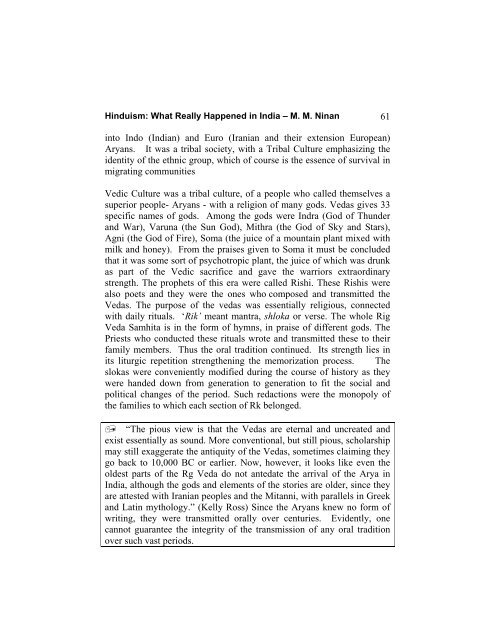Hinduism: What Really Happenned in India (PDF) - Oration
Hinduism: What Really Happenned in India (PDF) - Oration
Hinduism: What Really Happenned in India (PDF) - Oration
You also want an ePaper? Increase the reach of your titles
YUMPU automatically turns print PDFs into web optimized ePapers that Google loves.
<strong>H<strong>in</strong>duism</strong>: <strong>What</strong> <strong>Really</strong> Happened <strong>in</strong> <strong>India</strong> – M. M. N<strong>in</strong>an<br />
<strong>in</strong>to Indo (<strong>India</strong>n) and Euro (Iranian and their extension European)<br />
Aryans. It was a tribal society, with a Tribal Culture emphasiz<strong>in</strong>g the<br />
identity of the ethnic group, which of course is the essence of survival <strong>in</strong><br />
migrat<strong>in</strong>g communities<br />
Vedic Culture was a tribal culture, of a people who called themselves a<br />
superior people- Aryans - with a religion of many gods. Vedas gives 33<br />
specific names of gods. Among the gods were Indra (God of Thunder<br />
and War), Varuna (the Sun God), Mithra (the God of Sky and Stars),<br />
Agni (the God of Fire), Soma (the juice of a mounta<strong>in</strong> plant mixed with<br />
milk and honey). From the praises given to Soma it must be concluded<br />
that it was some sort of psychotropic plant, the juice of which was drunk<br />
as part of the Vedic sacrifice and gave the warriors extraord<strong>in</strong>ary<br />
strength. The prophets of this era were called Rishi. These Rishis were<br />
also poets and they were the ones who composed and transmitted the<br />
Vedas. The purpose of the vedas was essentially religious, connected<br />
with daily rituals. ‘Rik’ meant mantra, shloka or verse. The whole Rig<br />
Veda Samhita is <strong>in</strong> the form of hymns, <strong>in</strong> praise of different gods. The<br />
Priests who conducted these rituals wrote and transmitted these to their<br />
family members. Thus the oral tradition cont<strong>in</strong>ued. Its strength lies <strong>in</strong><br />
its liturgic repetition strengthen<strong>in</strong>g the memorization process. The<br />
slokas were conveniently modified dur<strong>in</strong>g the course of history as they<br />
were handed down from generation to generation to fit the social and<br />
political changes of the period. Such redactions were the monopoly of<br />
the families to which each section of Rk belonged.<br />
“The pious view is that the Vedas are eternal and uncreated and<br />
exist essentially as sound. More conventional, but still pious, scholarship<br />
may still exaggerate the antiquity of the Vedas, sometimes claim<strong>in</strong>g they<br />
go back to 10,000 BC or earlier. Now, however, it looks like even the<br />
oldest parts of the Rg Veda do not antedate the arrival of the Arya <strong>in</strong><br />
<strong>India</strong>, although the gods and elements of the stories are older, s<strong>in</strong>ce they<br />
are attested with Iranian peoples and the Mitanni, with parallels <strong>in</strong> Greek<br />
and Lat<strong>in</strong> mythology.” (Kelly Ross) S<strong>in</strong>ce the Aryans knew no form of<br />
writ<strong>in</strong>g, they were transmitted orally over centuries. Evidently, one<br />
cannot guarantee the <strong>in</strong>tegrity of the transmission of any oral tradition<br />
over such vast periods.<br />
61



